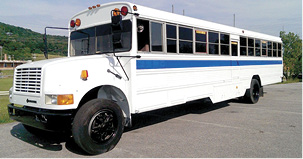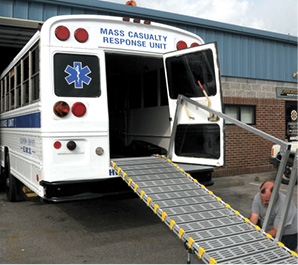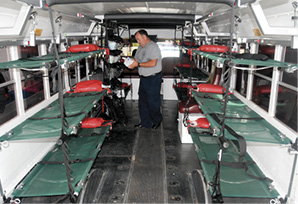Mass casualty response vehicle will serve region’s needs
The Clinton County Emergency Services Management has been working on a project for more than three years and is just now almost complete.
More than 120 hours have been spent retrofitting and outfitting a bus that can be used in case of a catastrophic event.
Mass Casualties 14 or MC14 is a bus retrofitted with a product called AMBUBUS which is a type of support system that can support up to 12 stretcher patients during an emergency.
Paramedic Mark Thrasher, has been one of the primary hands working on this project during the past three years and has done most of the work inside the bus in the past seven months.
“We’ve had several people come in and help us put this project together,” Thrasher said. “Me and (Paramedic) Jerry Harrison have worked together on most of the stuff in the bus.”
The grant came from the Lake Cumberland District Health Department and it is responsible for getting the grant funds in order to complete this project. It also came in partnership with the Healthcare Preparedness Coalition.
The bus was donated by the Clinton County School System and according to Thrasher, it is in great shape.
EMS Director Lonnie Scott first learned the school was going to surplus two buses before school was out in 2013.
Scott said getting this project was kind of like a Catch 22 in that the HPC said they would give Clinton County a grant for the bus once a bus was in the county’s possession, but the school board said they would donate a bus once the grant came through.
Once it was established Clinton County was going to receive the grant to outfit a bus into a mobile casualty unit, the grant was received and work began on making the project a reality.
“It runs great and is mechanically sound,” Thrasher said. “The outside was painted by the vocational school in Somerset. We provided the materials and they did the work.”
Thrasher said it was painted in Somerset because the vocational school is equipped to paint air planes, so they had a place to accommodate a full size bus.
Inside the bus, a portable rack was installed that will hold 12 patients, plus the rear of the bus is open to hold two to three wheelchair patients. Two stretchers can fit in the isle of the bus if need be, bringing the capacity to 18 people.
There are several items the bus still needs before it can be site ready. One of which is an air conditioner, as well as oxygen tanks to mount under the bus in order to supply patients with oxygen during transport.
“Of course, the intention is if you have the big and bad, whether it be a car wreck or fire or have to evacuate for some purpose we can,” Thrasher said. “It’s a pretty neat outfit. You can tell the military has designed it, planed and put it together.”
Even though the bus will be stationed in Clinton County, it is a regional bus and can be dispatched to other counties in the area which are under the LCDHD.
Those counties include Adair, Casey, Clinton, Cumberland, McCreary, Pulaski, Russell, Taylor and Wayne counties.
“It will be used inside any of the LCDHD region,” Thrasher said. “Obviously we will make it available to anywhere close. We have mutual-aid agreements with Pickett County (Tenn) and Jamestown, (Tenn). Any place within an hour of here we can go.”
Each or the 15 spots for a stretcher patient can be secured with straps and seatbelts for safe transport.
“Each patient is set into this webbing material and each one is rated for 3,000 pounds which just amazes me,” Thrasher said. “The fact that a one-inch wide webbing can hold that kind of weight is crazy.”
The kit is designed to be semi-permanent. If the situation calls it can be removed from the bus and set up on its own.
“If you have a bus where the engine goes out or whatever, in an hour you can have the whole kit apart and ready to go into a different bus,” Thrasher said. “I think it will be very handy … especially when you figure in the amount of cost, minus the grant money, the county was out on this project … It was just pennies.”
Another thing that makes this bus unique is the fact there is not another one close to Clinton County.
Scott said there are three of these types of buses in the state, but they are located in Western Kentucky.
“It’s turned out pretty good. We’ve been working on the thing for about three years,” Scott said. “There is not a kit in the eastern part of the state. It’s basically a state asset assigned bus. One company wanted us to bring the bus in and permanently mount a kit in it. This kit can come out so it’s more versatile. If you get a newer bus you can pop this one out and put it in a newer bus. This kit was a little higher on cost, but we felt long term it would be justifiable.”



Above, EMT Mark Thrasher installed a ramp on the back of MC14 (Mass Casualties 14) Monday morning. The three-year project is almost complete and ready for operation. Below, the inside of the bus has the capability of transporting a total of 18 patients in case an evacuation is needed.



